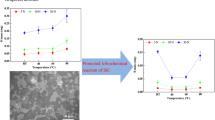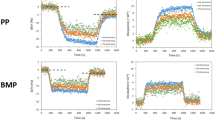Abstract
It is necessary to modify the running-in process for the application of ceramics using water as a lubricant in real conditions because ceramics sliding in water are characterized by a running-in period with severe friction and wear. Fullerenol, a kind of highly water-soluble nanoparticle, was synthesized and then used to ameliorate the tribological properties of Si3N4 sliding against Al2O3 in pure water. With the addition of fullerenol, the running-in period was shortened from 30 min to 100 s at a speed of 250 mm/s. The speed threshold above which ultralow friction can be obtained in a short time was expanded from 450 mm/s to 80 mm/s. Meanwhile, the load-carrying ability of water film was increased. The role of fullerenol was discussed based on observation of the wear scar by an optical interferometer and XPS characterization of the tribo-film on the wear track.
Similar content being viewed by others

References
Sulek M W, Wasilewski T. Tribological properties of aqueous solutions of alkyl polyglucosides. Wear, 2006, 260(1–2): 193–204
Graca M, Bongaerts J H, Stokes J R, et al. Friction and adsorption of aqueous polyoxyethylene (Tween) surfactants at hydrophobic surfaces. J Colloid Interface Sci, 2007, 315(2): 662–670
Ma Z Z, Zhang C H, Liu S H, et al. Study of lubrication behavior of pure water for hydrophobic friction pair. Sci China Ser E-Tech Sci, 2009, 52(11): 3128–3134
Guan W H, Shen C Y, Wu C W. Synthesis of fullerene-itaconic acid copolymer nanoball and its lubrication properties study. Sci China Ser E-Tech Sci, 2001, 44(09): 137–141
Zhou F, Wang Y, Ding H Y, et al. Friction characteristic of micro-arc oxidative Al2O3 coatings sliding against Si3N4 balls in various environments. Surf Coat Tech, 2008, 202(16): 3808–3814
Zhou F, Chen K M, Wang M L, et al. Friction and wear properties of CrN coatings sliding against Si3N4 balls in water and air. Wear, 2008, 265(7–8): 1029–1037
Zhou F, Kato K, Adachi K, et al. Friction and wear properties of CNx/SiC in water lubrication. Tribol Lett, 2005, 18(2): 153–163
Tomizawa H, Fischer T E. Friction and wear of silicon nitride and silicon carbide in water: Hydrodynamic lubrication at low sliding speed obtained by tribochemical wear. Tribol T, 1987, 30(1): 41–46
Wong H C, Umehara N, Kato K. Frictional characteristics of ceramics under water-lubricated conditions. Tribol Lett, 1998, 5(4): 303–308
Chen M, Kato K, Adachi K. The comparisons of sliding speed and normal load effect on friction coefficients of self-mated Si3N4 and SiC under water lubrication. Tribol Int, 2002, 35(3): 129–135
Jahanmir S, Ozmen Y, Ives L K. Water lubrication of silicon nitride in sliding. Tribol Lett, 2004, 17(3): 409–417
Chen M, Kato K, Adachi K. Friction and wear of self-mated SiC and Si3N4 sliding in water. Wear, 2001, 250(1–12): 246–255
Jordi L, Iliev C, Fischer T E. Lubrication of silicon nitride and silicon carbide by water: Running in, wear and operation of sliding bearings. Tribol Lett, 2004, 17(3): 367–376
Rani D A, Yoshizawa Y, Hyuga H, et al. Tribological behavior of ceramic materials (Si3N4, SiC and Al2O3 in aqueous medium. J Eur Ceram Soc, 2004, 24 (10–11): 3279–3284
Chen M, Kato K, Adachi K. The difference in running-in period and friction coefficient between self-mated Si3N4 and SiC under water lubrication. Tribol Lett, 2001, 11(1): 23–28
Xu J, Kato K. Formation of tribochemical layer of ceramics sliding in water and its role for low friction. Wear, 2000, 245(1–2): 61–75
Gates R S, Hsu S M. Tribochemistry between water and Si3N4 and SiC: Induction time analysis. Tribol Lett, 2004, 17(3): 399–406
Hartung W, Rossi A, Lee S W, et al. Aqueous lubrication of SiC and Si3N4 ceramics aided by a brush-like copolymer additive poly (L-lysine)-graft-poly(ethylene glycol). Tribol Lett, 2009, 34(3): 201–210
Phillips B S, Zabinski J S. Ionic liquid lubrication effects on ceramics in a water environment. Tribol Lett, 2004, 17(3): 533–541
Lee K, Hwang Y, Cheong S, et al. Understanding the role of nanoparticles in nano-oil lubrication. Tribol Lett, 2009, 35(2): 127–131
Lee J, Cho S, Hwang Y, et al. Application of fullerene-added nano-oil for lubrication enhancement in friction surfaces. Tribol Int, 2009, 42(3): 440–447
Wu Y Y, Tsui W C, Liu T C. Experimental analysis of tribological properties of lubricating oils with nanoparticle additives. Wear, 2007, 262(7–8): 819–825
Ginzburg B M, Shibaev L A, Kireenko O F, et al. Antiwear effect of fullerene C60 additives to lubricating oils. Russ J Appl Chem, 2002, 75(8): 1330–1335
Matsubayashi K, Kokubo K, Tategaki H, et al. One-step synthesis of water-soluble fullerenols bearing nitrogen-containing substituents. Fullerenes Nanotubes Carbon Nanostruct, 2009, 17(4): 440–456
Gee M G. The formation of aluminum hydroxide in the sliding wear of alumina. Wear, 1992, 153(1): 201–227
Gates R S, Hsu S M. Tribochemical mechanism of alumina with water. Tribol T, 1989, 32(3): 357–363
Xu J, Kato K, Hirayama T. The transition of wear mode during the running-in process of silicon nitride sliding in water. Wear, 1997, 205(1–2): 55–64
Fischer T E, Zhu Z, Kim H, et al. Genesis and role of wear debris in sliding wear of ceramics. Wear, 2000, 245(1–2): 53–60
Hsu S M, Chen M. Wear prediction of ceramics. Wear, 2004, 256(9–10): 867–878
Author information
Authors and Affiliations
Corresponding author
Additional information
These authors contributed equally to this work.
Rights and permissions
About this article
Cite this article
Liu, Y., Wang, X., Liu, P. et al. Modification on the tribological properties of ceramics lubricated by water using fullerenol as a lubricating additive. Sci. China Technol. Sci. 55, 2656–2661 (2012). https://doi.org/10.1007/s11431-012-4938-y
Received:
Accepted:
Published:
Issue Date:
DOI: https://doi.org/10.1007/s11431-012-4938-y



